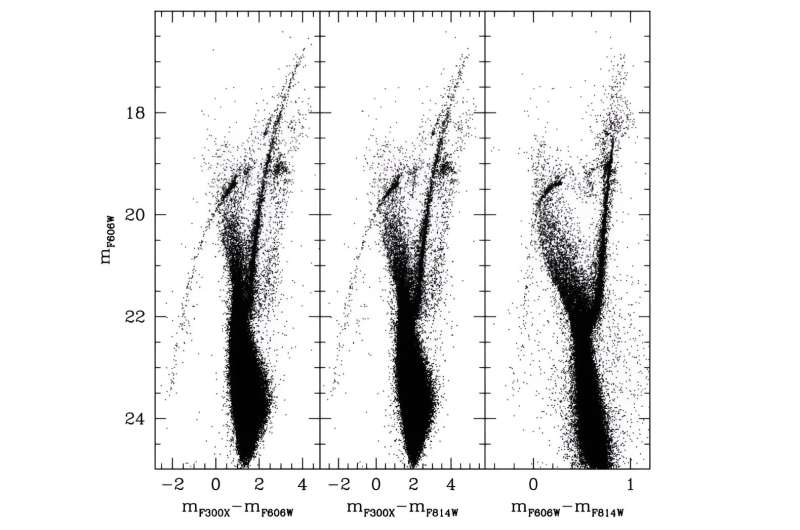March 6, 2024 report
This article has been reviewed according to Science X's editorial process and policies. Editors have highlighted the following attributes while ensuring the content's credibility:
fact-checked
preprint
trusted source
proofread
Extended horizontal branch detected in globular cluster NGC 1835

Using the Hubble Space Telescope (HST), astronomers have investigated the stellar population of the globular cluster NGC 1835. They detected a remarkably extended horizontal branch in this system. The discovery, reported February 28 on the preprint server arXiv, marks the first time when such a feature is found in a globular cluster beyond our Milky Way galaxy.
Globular clusters (GCs) are collections of tightly bound stars orbiting galaxies. Astronomers perceive them as natural laboratories enabling studies on the evolution of stars and galaxies. In particular, globular clusters could help researchers to better understand the formation history and evolution of early-type galaxies, as the origin of GCs seems to be closely linked to periods of intense star formation.
NGC 1835 is an old and massive globular cluster located close to the central bar of the Large Magellanic Cloud (LMC). The cluster is estimated to be about 13 billion years old and its mass is most likely at a level of 600,000 solar masses.
Recently, a team of astronomers led by Camilla Giusti of the University of Bologna in Italy, has inspected the stellar population of NGC 1835 as part of the ongoing research program studying the properties of old LMC clusters. For this purpose, they used optical and near ultraviolet images obtained with HST.
"In the framework of a project aimed at performing a new characterization of the oldest and most compact stellar systems in the LMC, we have presented a detailed multi-wavelength photometric study of the GC NGC 1835," the researchers wrote in the paper.
By analyzing the collected data, Giusti's team has identified the presence of a very extended blue tail of the horizontal branch (HB). In general, HB is a grouping of stars on the Hertzsprung-Russell (H-R) diagram that forms a horizontal line on this diagram, leading away from the red-giant branch (RGB). These stars have passed through the RGB and have begun helium fusion in the core, with a surrounding shell of hydrogen fusion.
The extended HB in NGC 1835 appears to span more than 4.5 magnitudes in both magnitude (in the near-ultraviolet and optical bands) and color from the region redder than the instability strip, covering effective temperatures from 5,000 to 30,000 K. It was found that the HB in this cluster includes a large population of RR Lyrae variables—67 confirmed and 52 new candidates.
The astronomers underlined that such an extended blue tail of the HB has been observed in only a few cases in our galaxy, including GCs like M3 and M13. However, such a feature has never been detected before in an extra-galactic cluster.
By comparing the HB in NGC 1835 with other GCs, it was found that it is a combination of HBs in M3 and M13. According to the paper, the morphology of the HB in NGC 1835 showcases a striking similarity when compared with the HB in M13, which suggests that the investigated GC may also host a population of slowly cooling white dwarfs—like M13.
More information: Camilla Giusti et al, Discovery of an extended Horizontal Branch in the Large Magellanic Cloud globular cluster NGC1835, arXiv (2024). DOI: 10.48550/arxiv.2402.18389
Journal information: arXiv
© 2024 Science X Network





















